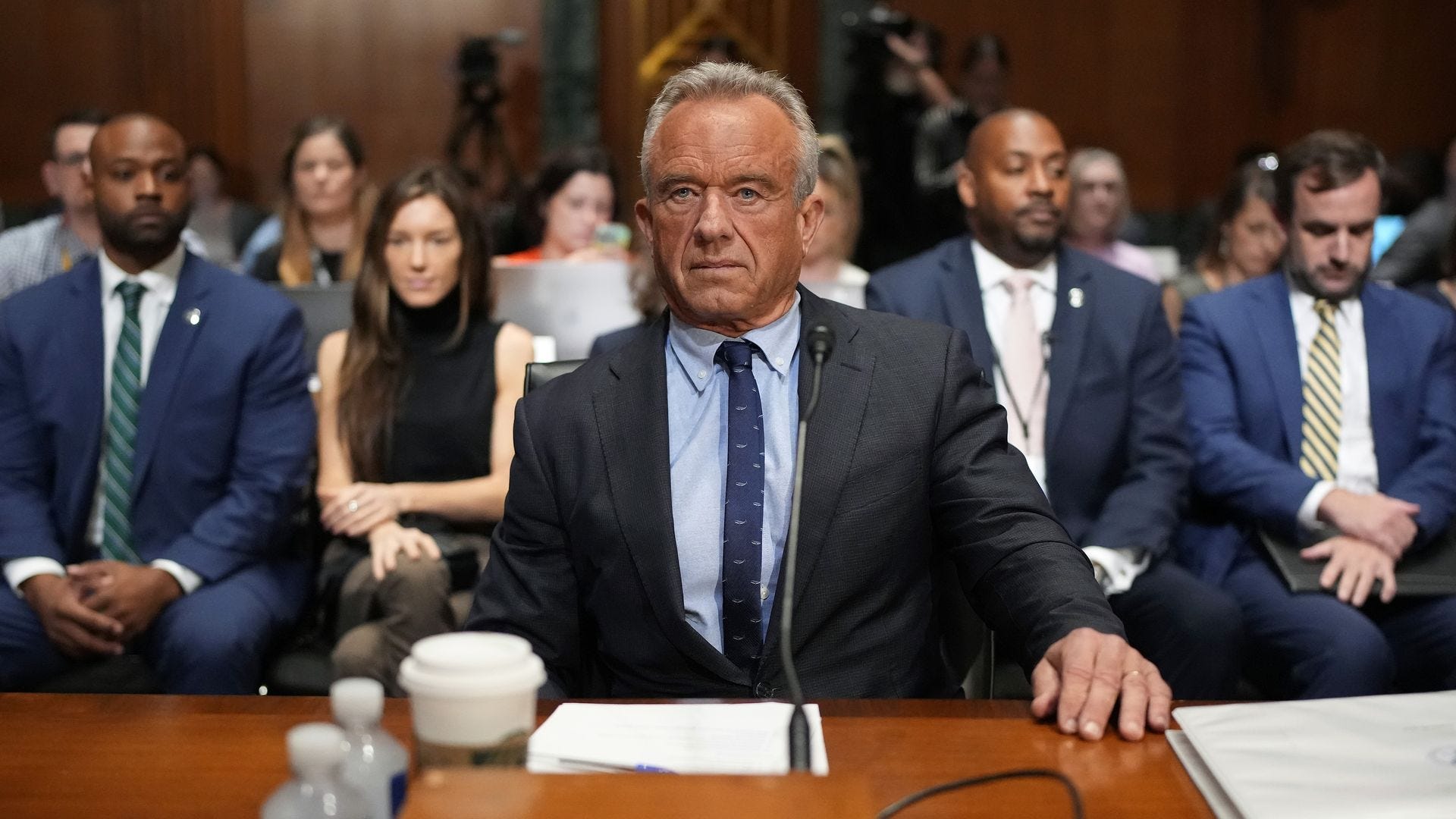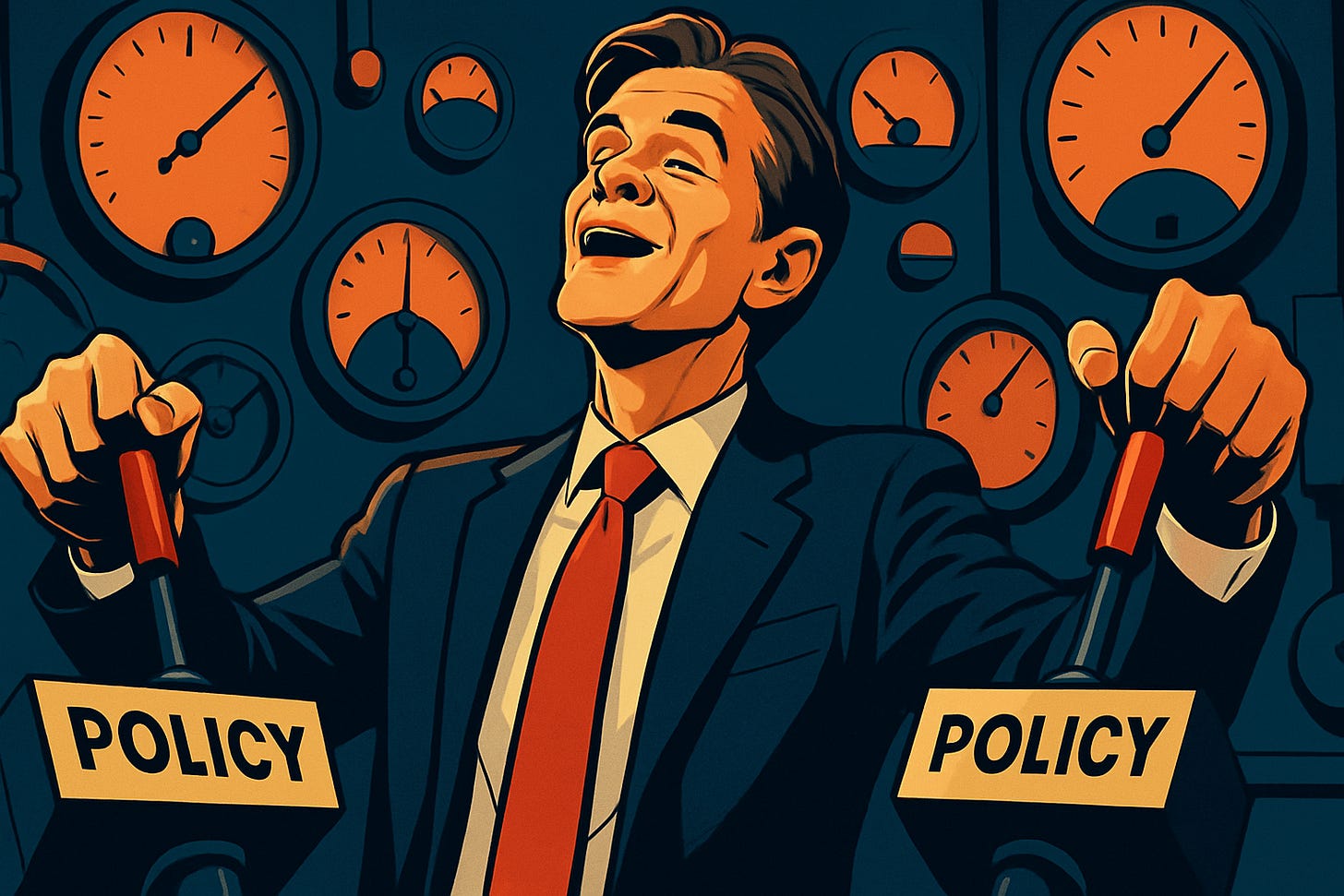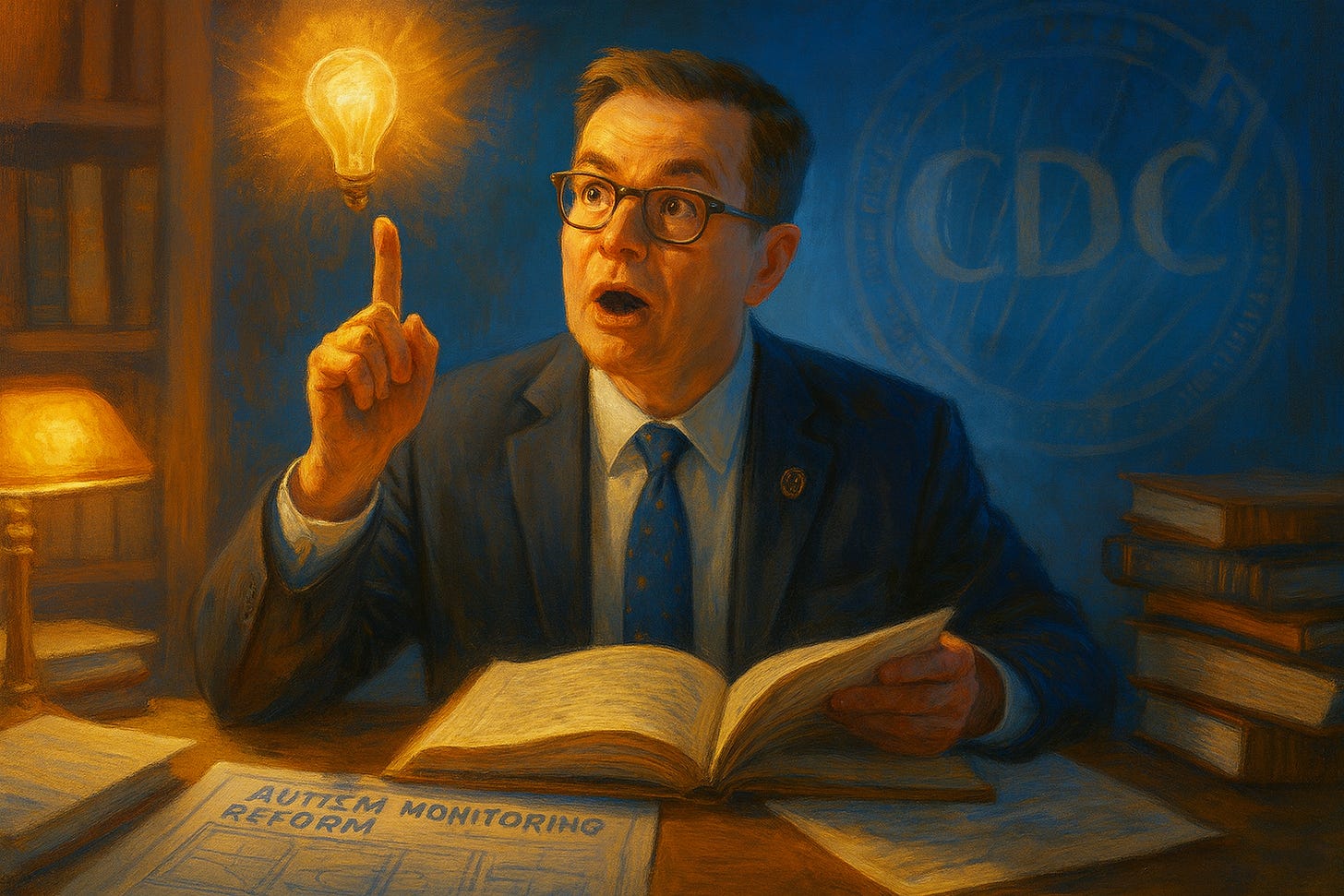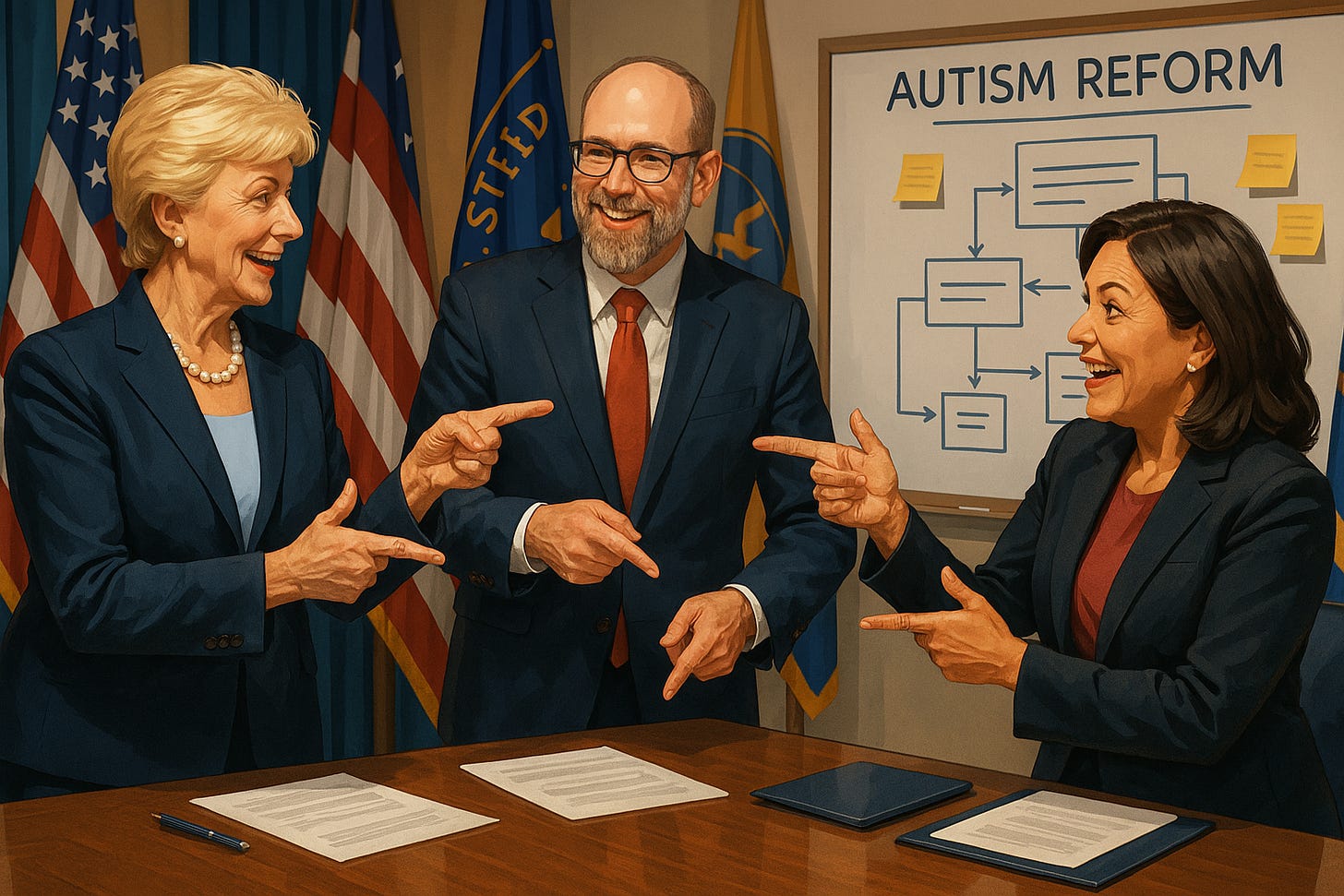How To End The Autism Epidemic
The autism "epidemic" is less an epidemic and more of a policy choice that the President has the authority to stop right now.
This was a timed post. The way these work is that if it takes me more than one hour to complete the post, an applet that I made deletes everything I’ve written so far and I abandon the post. You can find my previous timed post here.
Large numbers of Americans believe that there is an autism “epidemic”—an enormous increase in the portion of the population that has autism. The reality is much more mundane; the truth is that larger and larger portions of the population are being diagnosed with autism. This distinction is key to understanding the epidemic. The epidemic is artefactual: not real, not about autism actually becoming more common, not about neurological disorders proliferating, etc. etc. etc.
What’s the Deal With Autism Rates?
One of the major priorities of the new Secretary of Health and Human Services (HHS), Robert F. Kennedy Jr. (RFK Jr.), is to figure out why rates of autism have been increasing over time.
The clearest illustrations of this fact come to us when states change their policies about identifying students with autism. Consider this quote from the article just above:
We can be certain that autism rates have gone up for artefactual reasons—diagnosis, changing awareness and incentives, etc. rather than real increases in the number of people with autism—by exploiting policy changes. For example… I mentioned that Massachusetts saw autism reports increase 400% in one year due to a change in school reporting. Similarly, when states implement a policy of rewarding school districts for diagnoses, diagnoses immediately rise by about 25%.
You’d have to be absurdly committed to the idea of a “real” autism epidemic to make the case that these sharp, single-year increases in diagnosed autism rates are actually emblematic of paperwork causing autism. Thanks to many other lines of evidence, we can be confident that it’s exactly this sort of thing that explains the rise more generally: not vaccines, not poisoning, not iPads and Roblox, nor anything that actually preserves the definition of autism diagnoses over time. These things are disqualified; their contributions are nada, zilch, zip, zero (p > 0.05).
But autism diagnoses still matter. When people are diagnosed, states distribute benefits. In some cases, those benefits result in people intentionally seeking out diagnoses to defraud the system (Minnesota has a stand-out example of this phenomenon). Moreover, the federal government mandates providing ‘all necessary care’ via laws like EPSDT. It’s for reasons like this that RFK Jr. has been informed that on its current trajectory, the cost of autism care will exceed $1 trillion annually by 2035.
This is why it’s crucial that RFK Jr. gets this right. He alone is positioned to fix this issue, to end the epidemic. He can’t do this by cutting back vaccine schedules, removing synthetic food dyes from the grocery aisle, or switching Americans to tallow instead of seed oils. If he cuts the epidemic back at all—and that is his prerogative—he’ll do it through regulatory reform.
Dr. Oz and the Levers of Policy
I used wording that assumes you read my prior article on the causes of the autism “epidemic”.
The Department of Health and Human Services (HHS) charges the Centers for Disease Control (CDC) and the Centers for Medicare and Medicaid Services (CMS) with modifying the global coding system for diseases and medical conditions used in medical facilities so that it can be put to use in the U.S. This system, the ICD-10, is instrumental to classifying patient diagnoses and even causes of death. The HHS can revise this system as it’s used for autism to tighten up coding and documentation requirements in a cost-saving, diagnosis-reducing fashion.
RFK Jr. can order Dr. Oz and Jim O’Neill to add required specifiers on diagnoses. For example, was a valid diagnostic instrument used? Was a multi-disciplinary team consulted, or just a single clinician? What’s the severity tier? The double-O team of Oz and O’Neill can also team up to exclude or include notes to curb the phenomenon of diagnostic substitution: if they so desire, they can ensure language disorder and intellectual disability cases aren’t defaulted to being classified as autism spectrum disorder (ASD) cases and, indeed, are not classified as ASD cases unless they meet the right criteria. If the double-O’s are feeling very ambitious, they can even create new subcodes under the ICD-10 ASD code F84.0 for “confirmed by standardized assessment” versus “provisional”, and require the correct subcode to bill Applied Behavior Analysis (ABA) style services. All of this can be done through the existing Coordination and Maintenance Committee (C&M).
Dr. Oz has much more to do here, and he’ll have to go it alone on the big-ticket items. Namely, Dr. Oz can re-baseline Medicaid and Children’s Health Insurance Program (CHIP) coverage rules to decouple services from the ASD label. Most children receiving ASD services are on Medicaid/Early and Periodic Screening, Diagnostic, and Treatment (EPSDT). If Dr. Oz wants to fix this, he can, via State Medicaid Director Letters (SMDs), issuing FAQs, and putting out State Health Official (SHO) and CMS Informational Bulletins (CIB), enhance requirements for coverage. For instance, Dr. Oz could update medical necessity documentation standards, for example by requiring ADOS-2/ADI-R or equivalent instruments be used, requiring multi-source histories, or requiring that developmental and psychiatric differentials be ruled out.
Through the same means, Dr. Oz can force periodic re-evaluations with standardized tools to continue using intensive services. This may sound cruel, but it is in keeping with typical Republican sentiment on means-testing; moreover, it is medically useful, as plenty of people regress to the mean and no longer qualify for a diagnosis at an immediate re-assessment, much less at a longer-term follow-up. Parents who still need intensive services won’t be very put out by re-assessment, as it’s really not a very involved process to layer on top of what they’re already doing, and some of those who don’t really need those services might back off due to any bit of added inconvenience. It’s a win for the budget and no real loss for parents, and Dr. Oz could make it happen right now. He could also add second-opinion requirements for high-intensity authorizations for when diagnosis is first made outside of a multi-disciplinary setting.
Though it sounds like it should hurt the budget, Dr. Oz could push coverage of need-based services under symptom codes without requiring an ASD label, to reduce the incentives to upcode a condition to ASD to ‘unlock’ care (an act which may, itself, prompt people to pursue additional care). Doing this would also lock people who don’t need certain types of care out of treatment they would’ve been able to pursue with an ASD diagnosis alone. An additional method Dr. Oz could pursue to limit diagnoses by in-school specialists could be to peel back “free-care” policy—but let’s call that an emergency measure.
Jim O’Neill and the Diagnosis Directives
O’Neill could compel the CDC to change from its current policy of promoting universal ASD screening at eighteen and twenty-four months. If HHS issues guidance to emphasize developmental surveillance and targeted ASD screening where concerns are present, that would be substantially more conservative, constraining diagnoses to those who need it rather than all those who can be misdiagnosed with autism. That means less pathologizing borderline cases and it’s consistent with the current U.S. Preventive Services Task Force statement on the matter.
Through the CDC’s Autism and Developmental Disabilities Monitoring (ADDM) Network and the National Center for Health Statistics (NCHS), O’Neill can standardize case definitions (e.g., require instrument-verified cases for surveillance counts or report them separately), demand collection of symptom data alongside diagnoses so that a drift-sensitive trend adjustment can be conducted, and he can disallow mixing DSM eras without bridge studies (which have been done before!). HHS controls these programs’ methods through the Interagency Autism Coordinating Committee (IACC) and the Office of National Autism Coordination (ONAC).
The double-O’s can come together and via the HHS Office of Inspector General and CMS, prioritize targeted audits on outlier growth in ASD diagnosing and ABA billing. There’s a lot of fraud and wasteful spending related to autism, and detecting it is actually not all that difficult. The double-O’s could require payer-level reporting that flags diagnosis-source patterns (e.g., same clinic mass-diagnosis). They could also use existing waste, fraud, and abuse detection tools and Transformed Medicaid Statistical Information System (T-MSIS) data requests to get at this issue.
In his role as Deputy Secretary, O’Neill can also get the Agency for Healthcare Research and Quality (AHRQ) to commission methodologically strict reviews on diagnostic accuracy and harms and on de-labeling strategies. These can feed IACC strategy and support CDC and CMS guidance updates. He could also work to commission studies on overdiagnosis, what appropriate diagnosis rates would look like, and so on, potentially answering the question the USPSTF couldn’t answer, about the utility (or lack thereof) of universal screening.
Interagency Coordination Problems: Operation Warptism!
To really wrangle the autism “epidemic” interagency coordination outside of HHS is required. Everything can’t just fall on Dr. Oz’s and Jim O’Neill’s’ shoulders. Specifically, a lot of this has to fall on Linda McMahon’s.
One of the biggest sources of diagnosis is the Individuals with Disabilities Education Act (IDEA). The Department of Education (ED) and HHS can jointly work on guidance to require documented adverse educational impact before assigning a student of the IDEA “autism” category for the purposes of the receipt of school services. They can also work to encourage services being provided under alternative categories such as speech/language issues and specific learning disability when ASD criteria are not strictly met.
To avoid parity conflicts, officials will need to promote stricter ASD documentation with diagnosis-agnostic access to core therapies. The Office of Personnel Management (OPM) can adopt that model for Federal Employees Health Benefits (FEHB) plans and the HHS can recommend it via the IACC and interagency tasking (purchasing and plan guidance). Do this right, and the HHS can accrue a lot of savings through symptom-based service provisioning without diagnostic upcoding.
Change the Culture
Some of this might go beyond basic interagency coordination, unfortunately, requiring Congress to get involved. For example, statutory changes might be required to the Autism CARES Act to mandate instrument-verified surveillance and reporting or to condition certain grants on quality diagnostic metrics. But this is where RFK Jr. is needed: he needs to propose Congress do this work. While he’s at it, he can call for reform of IDEA regulatory definitions and eligibility thresholds both by the ED via rulemaking and in Congress, when the changes are too large to be done directly at the ED.
Perhaps more importantly than pushing Congress and supporting coordination, RFK Jr. could put diagnostic drift on the national agenda via a Surgeon General Advisory. These are intended to be used to reset norms by defining a problem, concretizing actions for actors at different levels (clinicians, schools, insurers, etc.) and they get a lot of media hype. Since awareness is an issue, this could materially help with the “epidemic” by changing the effect of awareness. RFK Jr. can also use the IACC as a coordinating engine to recenter practice norms. Make them publish a short “Practice Principles to Reduce Overdiagnosis/Overintensity” then echo that throughout HHS channels. That’d be relatively easy to promulgate and help a lot!
RFK Jr. can also get O’Neill to change the CDC’s long-running “Learn the Signs. Act Early.” messaging to focus on developmental variation, emphasizing targeted screening after surveillance, not reflexive mass labeling. To cut back on overdiagnosis, that could include a plain-English “What’s not ASD?” checklist. Changes to the C&M process, in which ASD subcodes are proposed, could also nudge clinics and plans towards instrument verification of diagnoses even before payer rules change.
In line with the push for improved measurement of care quality, the HHS could partner the AHRQ with the National Quality Forum (NQF) and National Committee for Quality Assurance (NCQA) to promote pediatric quality measures like “Percent of first-time ASD diagnoses with documented multidisciplinary evaluation”, or “Percent of intensive services with 12-month objective reevaluation”. Healthcare Effectiveness Data and Information Set (HEDIS) and NQF signals guide accreditation and payment.
There’s Much More To Do
The reason there’s an “autism epidemic” is because of a morass of statutory, regulatory, and cultural changes that have occurred since DSM-III met the demands of the Education for All Handicapped Children Act and its successor legislation. To correct this trend and ensure that the country treats only those who need to be treated, in ways that are appropriate and cost-effective, federal agencies and Congress will have to take a coordinate approach. What I’ve outlined here is just a small part of what needs to be done. Actually fixing the autism issue requires a lot of grunt work.
But nothing short of doing this work will actually fix the issue without catastrophically negative impacts. You could coerce the DSM-6 into having an unworkable autism definition like Kanner’s original one, thus ending the epidemic because no one can legitimately be diagnosed. But that would be far from optimal because so many children diagnosed with autism genuinely benefit from the services they receive. For that reason, I’ll reiterate: this work has to be done and done right.
But if the work gets done, the autism epidemic will end and America will save a lot of money and be spared a ton of grief.








You wrote all this in one hour? You must be more autistic than me. (I mean that as a great compliment.)
Thank you for writing this detailed post! Let me add two minor suggestions.
First, NIH needs to focus research dollars on the profound end of the autism spectrum and heavily scrutinize study proposals that fail to deliberately consider profundity. Kids with level 1 autism who are fine in a general education classroom just aren’t the same as level 3 kids who need a high-intensity special ed setting, but it’s much easier to recruit level 1 kids and make over broad claims about your results.
Second, all of these programs need a fast-track approval process for genetic diagnoses with autism as a secondary diagnosis. Kids with, say, Angelman Syndrome aren’t going to stop needing a high amount of services. Genetic screening these days is cheap enough that private insurance encourages it and provides fast-track approvals for kids with genetic disorders.